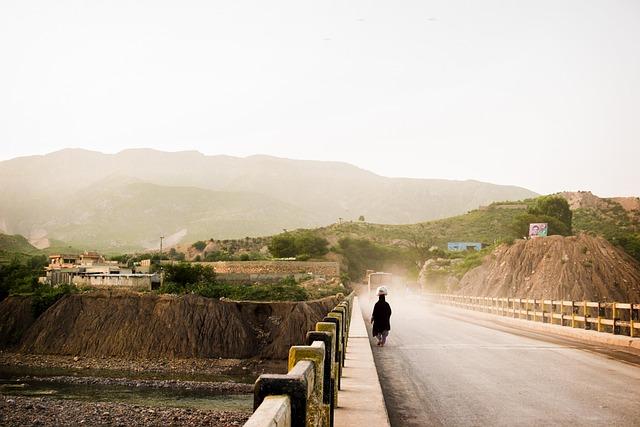Revitalizing Pakistan’s Economy: Strategies for Global Trade Success
In the ever-evolving arena of global commerce, Pakistan stands at a crossroads, rich in potential yet grappling with a myriad of economic challenges. Nestled at the heart of South Asia, this vibrant nation is steeped in a history of trade that dates back to ancient civilizations. Today, as the world shifts toward an interconnected marketplace, Pakistan’s opportunity to reclaim its position as a regional economic powerhouse is more pertinent than ever. This article delves into the myriad strategies that can propel Pakistan towards a path of sustainable growth and global trade success. By examining innovative practices, leveraging natural resources, and fostering international partnerships, we will explore how Pakistan can transform its economic landscape while navigating the complexities of modern trade dynamics. Join us as we embark on a journey to uncover the key ingredients for a flourishing future on the global stage.
Revamping Trade Policies for Enhanced Global Competitiveness
The current landscape of global trade demands that nations continually innovate and adapt their policies to enhance competitiveness. One key strategy for Pakistan is to streamline customs procedures and reduce bureaucratic red tape. By simplifying these processes, businesses can save time and resources, enabling them to focus on production and innovation. Additionally, strengthening trade agreements with strategic partners can open new markets for Pakistani products, fostering economic diversification. Collaboration with international organizations can also help facilitate access to knowledge and resources essential for improving trade infrastructure.
Another vital area of focus is investing in technology and digital transformation. By embracing e-commerce and digital platforms, Pakistani businesses can reach a broader audience and increase export potential. The government must support the development of digital skills to equip the workforce for a modern economy. Moreover, establishing fair pricing and subsidy policies can empower local producers while ensuring that consumers benefit from competitive pricing. Below is a comparison table illustrating potential benefits of investing in trade policy revamp versus maintaining the status quo:
| Investment in Trade Policy | Status Quo |
|---|---|
| Increased market access | Limited global reach |
| Boosted exports | Stagnant trade growth |
| Job creation in diverse sectors | Job losses in uncompetitive industries |
| Enhanced foreign investment | Investor hesitance |

Investing in Infrastructure: The Backbone of Economic Growth
Investing in infrastructure plays a pivotal role in laying the groundwork for a thriving economy. The interdependence between robust infrastructure and economic prosperity is evident as countries that prioritize improvements in their transport, energy, and digital frameworks consistently outperform those that don’t. Key areas of focus should include:
- Transportation Networks: Enhanced roadways, railways, and ports facilitate smoother trade and connectivity.
- Energy Supply: Reliable energy sources drive manufacturing and service sectors, essential for global competitiveness.
- Digital Infrastructure: High-speed internet and telecommunications enable businesses to access global markets seamlessly.
Moreover, an aggressive approach to revamping infrastructure can stimulate job creation and foster private sector investments. Effective public-private partnerships can unlock additional capital and expertise, essential for executing large-scale projects. To illustrate this potential, consider the following table highlighting key infrastructure projects that could catalyze economic growth:
| Project Name | Type | Estimated Cost (USD) | Projected Completion |
|---|---|---|---|
| Karachi Circular Railway | Urban Transport | 300 million | 2025 |
| Diamer-Bhasha Dam | Water & Energy | 14 billion | 2028 |
| Multan-Sukkur Motorway | Road Development | 2 billion | 2024 |

Cultivating Innovation and Technology for Sustainable Development
In today’s rapidly evolving landscape, harnessing cutting-edge technologies plays a crucial role in crafting innovative solutions that drive sustainable progress. By fostering a culture of collaboration between government, private sectors, and academia, Pakistan can harness the potential of breakthroughs in renewable energy, agriculture, and smart technology. This multidisciplinary approach not only enhances productivity but also ensures that economic growth aligns with environmental stewardship. With strategic investments, we can look at integrating technologies such as artificial intelligence, IoT, and blockchain, effectively streamlining industries and enhancing global competitiveness.
Moreover, implementing incubation programs and innovation hubs can stimulate entrepreneurship across various sectors. These platforms can focus specifically on developing sustainable practices and technologies that cater to local needs while keeping an eye on the global market. Key strategies may include:
- Promoting Research and Development: Allocate resources to fundamental research that inspires innovative applications.
- Encouraging Public-Private Partnerships: Link governmental initiatives with private sectors to boost investment in green technologies.
- Facilitating Skill Development: Launch training programs that equip the workforce with necessary digital and technical skills to thrive.
To illustrate the potential benefits of integrating technology into various sectors, consider the following table that showcases some innovative technologies applicable to key industries:
| Industry | Innovative Technology | Impact on Sustainability |
|---|---|---|
| Agriculture | Precision Farming | Reduces waste and optimizes resource usage |
| Energy | Solar Panels | Provides clean energy and lowers carbon footprint |
| Manufacturing | 3D Printing | Minimizes material waste and increases customization |

Strengthening International Partnerships and Market Access Strategies
To foster a robust economy, it is essential for Pakistan to cultivate strong international partnerships that can unlock new markets and opportunities. Collaboration with global businesses and governments can lead to increased trade volume and investment inflow. By participating in international trade agreements, Pakistan can benefit from reduced tariffs, access to advanced technology, and sharing of best practices in various sectors. Engaging with countries that have a strong industrial base offers the potential for joint ventures and cooperative initiatives aimed at enhancing production capacities.
Alongside strengthening partnerships, developing effective market access strategies is crucial for empowering local businesses to compete internationally. This involves identifying key export markets and tailoring products to meet diverse consumer demands. Implementing strategic marketing efforts, including attendance at international trade fairs and utilizing digital platforms, can elevate Pakistan’s presence on the global stage. Additionally, maintaining high-quality standards and compliance with international regulations will ensure that products are not just accessible but also desirable and competitive. Below is a brief summary of important market access strategies:
| Strategy | Description |
|---|---|
| Market Research | Analyze potential markets to understand consumer preferences. |
| Trade Agreements | Engage in bilateral and multilateral trade deals. |
| Quality Assurance | Implement standards that reflect international quality demands. |
| Digital Marketing | Utilize online platforms to reach global customers. |
The Way Forward
As we conclude our exploration of the strategies to revitalize Pakistan’s economy through global trade, it becomes clear that the path forward is not without its challenges. However, with a commitment to innovation, strategic partnerships, and a focus on sustainable practices, there exists a wealth of opportunity to reposition Pakistan within the competitive landscape of international markets.
By fostering an environment that prioritizes infrastructure, education, and technology, Pakistan can not only enhance its trade capabilities but also empower its people and bolster its economic resilience. The vision of a thriving economy is not merely an aspiration; it is a potential future that requires collective effort and consistent execution of strategic initiatives.
Ultimately, the success of these endeavors will hinge on collaboration among government, private sector, and civil society. Together, they can harness the strengths of Pakistan’s diverse resources and untapped markets. As we move forward, it is critical to remain adaptable, responsive, and optimistic about the opportunities that global trade presents, ensuring that Pakistan emerges as a formidable player on the world stage. In this journey of transformation, every step counts—let us take them with purpose and determination.



